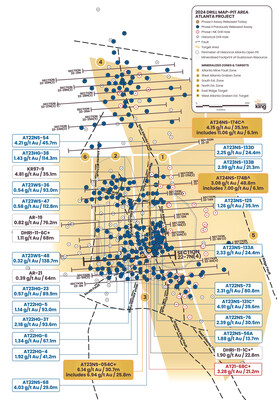NEVADA KING INTERCEPTS 6.14 G/T AU OVER 30.7M, 4.15 G/T AU OVER 35.1M AND 3.08 G/T AU OVER 48.8M, CONFIRMS STRONG INTRUSIVE CONNECTION TO GOLD MINERALIZATION AT ATLANTA
Rhea-AI Summary
Nevada King Gold Corp. (TSXV: NKG) (OTCQX: NKGFF) announced assay results from one metallurgical core hole and two reverse circulation (RC) holes at its Atlanta Gold Mine Project. Key intercepts include:
- 6.14 g/t Au over 30.7m
- 4.15 g/t Au over 35.1m
- 3.08 g/t Au over 48.8m
These results confirm a strong intrusive connection to gold mineralization along the West Atlanta Fault (WAF) zone. Significant high-grade gold was identified, with some intervals showing up to 11.06 g/t Au. The project aims to refine its geological model using detailed trace element geochemistry to differentiate protolith types and identify critical structures responsible for gold mineralization.
Positive
- Intercepts include high-grade gold: 6.14 g/t Au over 30.7m, 4.15 g/t Au over 35.1m, and 3.08 g/t Au over 48.8m.
- Confirms a strong intrusive connection to gold mineralization along the West Atlanta Fault.
- Detailed geochemical analysis helps refine the geological model, aiding future exploration.
- Potential for high-grade gold zones with up to 11.06 g/t Au in specific intervals.
Negative
- True mineralized thickness is estimated to be 35% to 45% of reported intercept length, potentially lower than initial figures suggest.
News Market Reaction 1 Alert
On the day this news was published, NKGFF gained 4.25%, reflecting a moderate positive market reaction.
Data tracked by StockTitan Argus on the day of publication.
Highlights:
Hole No. | From (m) | To (m) | Interval (m) | Au (g/t) | Ag (g/t) | Zone |
AT23NS-54C+ | 160.1 | 190.9 | 30.7 | 6.14 | 79.3 | WAF |
includes | 162.3 | 188.1 | 25.8 | 6.94 | 90.5 | WAF |
AT24NS-174B^ | 109.8 | 158.5 | 48.8 | 3.08 | 33.2 | WAF |
includes | 118.9 | 125.0 | 6.1 | 7.00 | 75.5 | WAF |
AT24NS-174C^ | 103.7 | 138.7 | 35.1 | 4.15 | 47.4 | WAF |
includes | 105.2 | 111.3 | 6.1 | 11.06 | 110 | WAF |
Table 1. Holes released today. Mineralization occurs along the northerly-trending West Atlanta Fault within an intrusive breccia zone dipping 60o to 70o west. True mineralized thickness estimated to be |
- Core hole AT23NS-54C intercepted 6.14 g/t Au and 79.3 g/t Ag over 30.7m and was sited to collect mineralized silica breccia occurring along the West Atlanta Fault ("WAF") for the ongoing Phase II metallurgical testwork program. The WAF forms the fault boundary between the Atlanta Mine Fault Zone ("AMFZ") on the east and the West Atlanta Graben Zone ("WAGZ") on the west.
- Angle holes AT24NS-174B (3.08 g/t Au over 48.8m) and AT24NS-174C (4.15 g/t Au over 35.1m) were designed to infill a gap in drill coverage along the western side of the AMFZ and also track the southern extension of the northerly-trending high-grade intrusive contact in the hanging wall of the WAF that was intercepted in adjacent holes (see Table 2 below) along lines both north and south of Section 23-7N(4) as shown in Figure 3.
- These closely-spaced angle holes clearly demonstrate a consistent 60o to 70o west dip to this mineralized zone that likely served as the
Atlanta deposit's main hydrothermal flue (or feeder) along the WAF. The zone is between 15m and 20m true thickness and is bounded on the east by massive Eureka Quartzite. Mineralization is hosted within strongly silicified fault and hydrothermal breccias mixed with silicified volcanics and narrow intrusive dikes. The highest gold grades tend to occur along contacts with silicified porphyritic rhyolite dikes. - As shown in Figure 3, this high-grade, intrusive dominated zone looks to vear NW and pinch out but remains open to the south where it appears to widen and curve southwestward and possibly connect to more high-grade intercepts along Section 22-4N.
- Referring to Figure 2, gold mineralization thickens and flattens moving westward and eastward from this WAF feeder zone as the hydrothermal fluids migrated laterally into receptive volcanic and intrusive host rocks within the adjacent WAGZ as well as along the low-angle unconformity separating younger volcanics and intrusions from underlying Paleozoic basement rocks in the AMFZ. The silica breccia unit hosting most of the mineralization along the fault was originally interpreted as having formed along the sub-horizontal unconformity and subsequently down dropped in a step-like manner across the fault zone. However, recent re-logging of drill data revealed that much of the silica breccia within this steeply dipping structure is intensely silicified, brecciated rhyolitic intrusive rock as opposed to strongly silicified dolomitic rock underneath the unconformity. Trace element enrichment in chromium coupled with depletion of titanium and magnesium within the silica breccia confirm a largely rhyolitic host rock (prolith). Understanding this direct relationship between rhyolitic intrusions and high-grade gold mineralization could be a key indicator for understanding and potentially targeting gold distribution throughout the
Atlanta district.
Cal Herron, Exploration Manager of
Line | Hole No. | From (m) | To (m) | Interval (m) | Au (g/t) |
9 | AT23NS-133E* | 122.0 | 202.7 | 80.8 | 1.99 |
includes | 196.6 | 198.2 | 1.5 | 10.25 | |
8 | AT22NS-053 | 157 | 224.1 | 67.1 | 2.88 |
includes | 205.8 | 218.0 | 12.2 | 11.12 | |
8 | AT23NS-174* | 117.4 | 186.0 | 68.6 | 6.90 |
includes | 166.2 | 176.8 | 10.7 | 19.20 | |
8 | AT23NS-174A* | 118.9 | 196.6 | 77.7 | 4.90 |
includes | 169.2 | 172.3 | 3.0 | 19.35 | |
8 | AT23NS-133F* | 117.4 | 199.7 | 82.3 | 6.55 |
includes | 184.5 | 196.6 | 12.2 | 26.71 | |
7 | AT24NS-174B* | 109.8 | 158.5 | 48.8 | 3.08 |
includes | 118.9 | 125.0 | 6.1 | 7.00 | |
7 | AT24NS-174C* | 103.7 | 138.7 | 35.1 | 4.15 |
includes | 105.2 | 111.3 | 6.1 | 11.06 | |
6 | AT22NS-68 | 134.0 | 163.1 | 29.1 | 4.03 |
includes | 157.0 | 160.1 | 3.1 | 10.03 | |
6 | AT23NS-131C* | 132.6 | 172.3 | 39.6 | 4.91 |
includes | 144.8 | 154.0 | 9.2 | 12.94 |
Table 2. Mineralized intervals in RC holes defining a northerly-trending high-grade zone along the hanging wall side of the steeply west-dipping West Atlanta Fault ("WAF"). True mineralized thickness estimated to be between |
Hole No. | From (m) | To (m) | Interval (m) | Au (g/t) | Ag (g/t) | Zone |
AT23WS-47 | 219.5 | 332.3 | 112.8 | 0.58 | 3.2 | WAGZ |
AT23WS-48 | 207.3 | 346.0 | 138.7 | 0.32 | 5.3 | WAGZ |
AT23HG-38 | 214.9 | 329.3 | 114.3 | 1.43 | 16.5 | WAGZ |
AT23NS-131C* | 132.6 | 172.3 | 39.6 | 4.91 | 41.4 | WAF |
AT23NS-133A* | 99.1 | 123.5 | 24.4 | 2.33 | 24.6 | AMFZ |
AT23NS-133B* | 99.1 | 120.4 | 21.3 | 2.99 | 22.8 | AMFZ |
AT23NS-133D* | 73.2 | 97.6 | 24.4 | 2.25 | 23.3 | AMFZ |
AT23WS-36 | 242.4 | 335.4 | 93.0 | 0.54 | 7.6 | WAGZ |
AT22HG-6 | 189.0 | 256.1 | 67.1 | 1.34 | 6.4 | WAGZ |
AT23HG-23 | 227.1 | 317.1 | 89.9 | 0.57 | 11.5 | WAGZ |
AT23NS-125* | 74.7 | 109.8 | 35.1 | 1.26 | 31.9 | AMFZ |
AT22HG-5 | 186.0 | 279.0 | 93.0 | 1.14 | 2.1 | WAGZ |
AT22HG-3T | 170.4 | 285.4 | 93.6 | 2.18 | 17.1 | WAGZ |
AT22HG-4 | 175.3 | 240.9 | 41.2 | 1.92 | 22.7 | WAGZ |
AT22NS-68 | 134.1 | 163.1 | 29.0 | 4.03 | 21.2 | WAF |
AT22NS-54 | 170.7 | 216.5 | 45.7 | 4.21 | 79.6 | WAF |
AT22NS-56A | 93.0 | 106.7 | 13.7 | 1.88 | 38.5 | AMFZ |
AT22NS-76 | 70.1 | 100.6 | 30.5 | 2.39 | 41.5 | AMFZ |
AT22NS-73 | 22.9 | 103.7 | 80.8 | 2.31 | 47.4 | AMFZ |
AT21-68C+ | 99.1 | 120.3 | 21.2 | 3.28 | 34.4 | WAF |
Table 3. Previously reported holes used along updated Section 22-7N(3). AT22 series holes were drilled by |
Hole No. | From (m) | To (m) | Interval (m) | Au (g/t) | Ag (g/t) |
AR-21 | 240.8 | 304.8 | 64 | 0.39 | 4.21 |
AR-19 | 228.6 | 304.8 | 76.2 | 0.82 | 3.52 |
KR97-9* | 175.3 | 210.4 | 35.1 | 4.81 | 25.2 |
includes | 196.6 | 201.2 | 4.6 | 21.83 | 27.8 |
DHRI-11-6C+ | 227.1 | 295.1 | 68 | 1.11 | 15.7 |
DHRI-11-1C+* | 74.7 | 97.5 | 22.8 | 1.90 | 19.7 |
Table 4. Historical holes used in updated Section 22-7N(3). AR series holes were drilled by Goldfields in 1991. KR series holes were drilled by |
QAQC Protocols
All RC samples from the Atlanta Project are split at the drill site and placed in cloth and plastic bags utilizing a nominal 2kg sample weight. CRF standards, blanks, and duplicates are inserted into the sample stream on-site on a one-in-twenty sample basis, meaning all three inserts are included in each 20-sample group. Samples are shipped by a local contractor in large sample shipping crates directly to American Assay Lab in
Qualified Person
The scientific and technical information in this news release has been reviewed and approved by Calvin R. Herron, P.Geo., who is a Qualified Person as defined by National Instrument 43-101 ("NI 43-101").
About Nevada King Gold Corp.
The Atlanta Mine is a historical gold-silver producer with a NI 43-101 compliant pit-constrained resource of 460,000 oz Au in the measured and indicated category (11.0M tonnes at 1.3 g/t) plus an inferred resource of 142,000 oz Au (5.3M tonnes at 0.83 g/t). See the NI 43-101 Technical Report on Resources titled "Atlanta Property,
Resource Category | Tonnes | Au Grade | Contained Au | Ag Grade | Contained Au |
Measured | 4,130 | 1.51 | 200,000 | 14.0 | 1,860,000 |
Indicated | 6,910 | 1.17 | 260,000 | 10.6 | 2,360,000 |
Measured + Indicated | 11,000 | 1.30 | 460,000 | 11.9 | 4,220,000 |
Inferred | 5,310 | 0.83 | 142,000 | 7.3 | 1,240,000 |
Table 5. NI 43-101 Mineral Resources at the Atlanta Mine | |||||
Please see the Company's website at www.nevadaking.ca.
Neither the TSX Venture Exchange nor its Regulation Services Provider (as that term is defined in the policies of the TSX Venture Exchange) accepts responsibility for the adequacy or accuracy of this release.
Cautionary Statements Regarding Forward Looking Information
This news release contains certain "forward-looking information" and "forward-looking statements" (collectively "forward-looking statements") within the meaning of applicable securities legislation. All statements, other than statements of historical fact, included herein, without limitation, statements relating the future operations and activities of
![]() View original content to download multimedia:https://www.prnewswire.com/news-releases/nevada-king-intercepts-6-14-gt-au-over-30-7m-4-15-gt-au-over-35-1m-and-3-08-gt-au-over-48-8m-confirms-strong-intrusive-connection-to-gold-mineralization-at-atlanta-302164227.html
View original content to download multimedia:https://www.prnewswire.com/news-releases/nevada-king-intercepts-6-14-gt-au-over-30-7m-4-15-gt-au-over-35-1m-and-3-08-gt-au-over-48-8m-confirms-strong-intrusive-connection-to-gold-mineralization-at-atlanta-302164227.html
SOURCE Nevada King Gold Corp.












